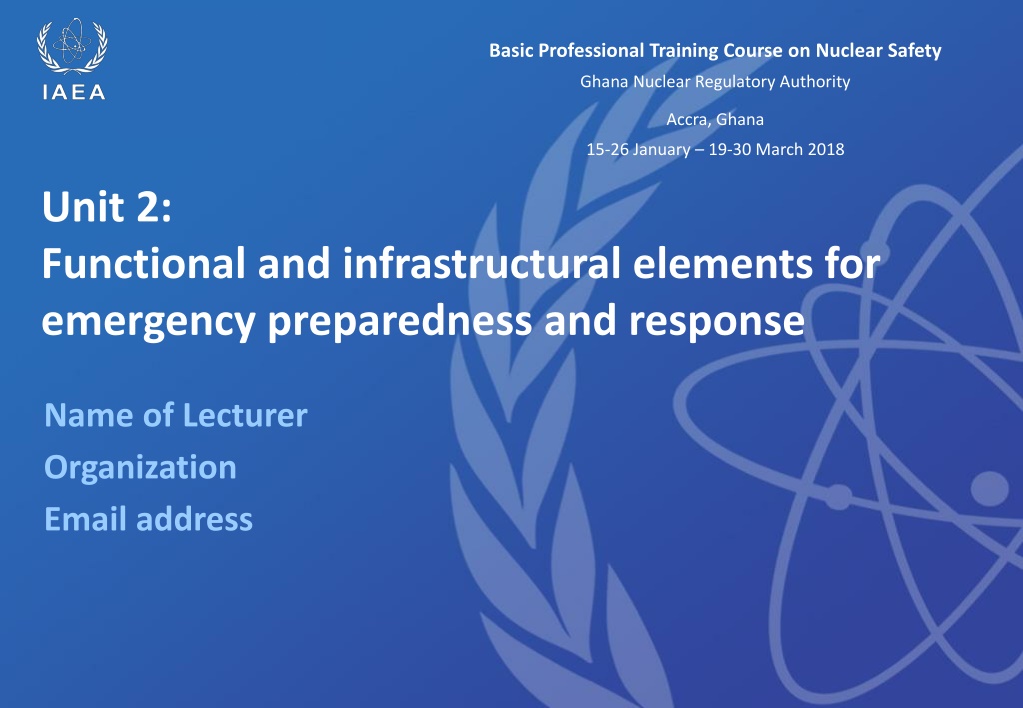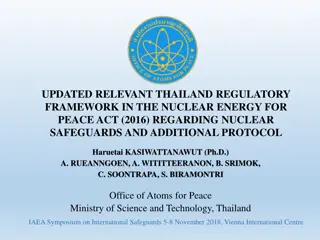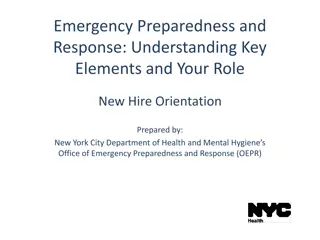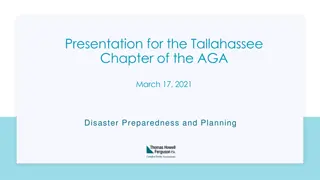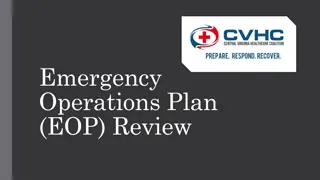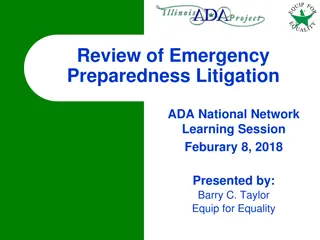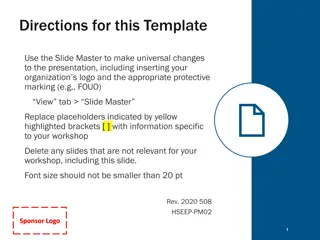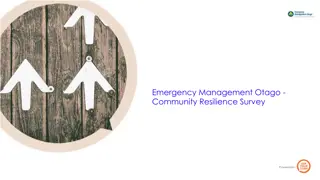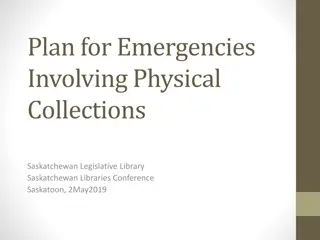Comprehensive Training on Nuclear Emergency Preparedness and Response
This course conducted by the Ghana Nuclear Regulatory Authority covers essential functional and infrastructural elements for emergency preparedness and response in nuclear or radiological incidents. Participants learn about response functions, building capabilities, managing operations, and implementing Incident Command Systems. The goal is to ensure effective and coordinated responses to nuclear emergencies, meeting international requirements.
Download Presentation

Please find below an Image/Link to download the presentation.
The content on the website is provided AS IS for your information and personal use only. It may not be sold, licensed, or shared on other websites without obtaining consent from the author. Download presentation by click this link. If you encounter any issues during the download, it is possible that the publisher has removed the file from their server.
E N D
Presentation Transcript
Basic Professional Training Course on Nuclear Safety Ghana Nuclear Regulatory Authority Accra, Ghana 15-26 January 19-30 March 2018 Unit 2: Functional and infrastructural elements for emergency preparedness and response Name of Lecturer Organization Email address
Learning objectives To become familiar with the functional and infrastructural elements which have to be in place at all levels when building the EPR framework, the associated international requirements and practical aspects for implementation 2
Contents 1. Functional elements for emergency preparedness and response 2. Infrastructural elements for emergency preparedness and response 3
Introduction Elements for sound preparedness and response for a nuclear or radiological emergency are divided into functional (response) elements and infrastructure (preparedness) elements The functional elements described in this lecture address the functions that are essential for an effective response in a nuclear or radiological emergency in order to achieve the emergency response goals An integrated set of infrastructural elements is to be established, for building adequate capabilities in support to the response functions 4
Basic Professional Training Course on Nuclear Safety Ghana Nuclear Regulatory Authority Accra, Ghana 15-26 January 19-30 March 2018 1. Functional elements for emergency preparedness and response
Managing operations in an emergency On-site emergency response promptly executed without impairing performance of normal operational safety functions Off-site emergency response coordinated with on-site response (EPC I and II) and between all jurisdictions, response organizations, and countries that fall within PAZ or UPZ to provide mutual support Appraise information on allocation of resources throughout emergency Arrangements made for implementation of an Incident Command System (ICS) for response to any nuclear or radiological emergency 6
Identifying, notifying and activating For facilities in EPC I, II & III Ensure operators promptly determine appropriate emergency class or level of response Initiate on-site actions Notify and provide updated information to off-site notification point Promptly notify all appropriate off-site response organizations Which will initiate pre-planned and coordinated responses appropriate to emergency class
Identifying, notifying and activating - contd Initiate appropriate emergency response actions upon receipt of notification by another State or IAEA of actual or potential transnational emergency In transnational emergency notifying State informs directly or through IAEA those States that may be affected
In practice Emergency classification system must be in place Off-site notification protocols and messages Means to activate critical staff 24 hrs / 7 days Means to notify other countries First responders aware of indicators of presence of radiation or radioactive material Medical doctors aware of symptoms that high dose of ionizing radiation can cause
Taking mitigatory actions Mitigatory actions refer to immediate actions to be taken on-site in order to: prevent severe damage to fuel in the reactor core or spent fuel pool, so that preventing a large release of radioactive material into the environment reduce the size of any release following damage to fuel delay a large release of radioactive material following damage to fuel to allow protective actions to be taken 10
Taking mitigatory actions contd Emergency operating procedures (EOP) To control transients such as Loss of Coolant Accidents, reactivity excursions, system failures, etc. Severe Accident Management Guidelines (SAMG) To prevent releases when EOPs don t work anymore Firefighting Damage control
Taking urgent protective actions and other response actions Urgent protective actions are meant to: prevent severe deterministic effects reduce the risk of stochastic effects (cancers) prevent the public from doing more harm than good when protecting themselves
Taking urgent protective actions and other response actions cont d Two possibilities: 1. Before or shortly after the release based on EALs (upon declaration of a general emergency), according to the pre-developed protection strategy 2. After the release, based on OILs, through conducting monitoring and sampling programmes Arrangements must be made in the preparedness stage to effectively and safely take urgent protective actions 13
Public protective actions Urgent protective actions o Referred to as precautionary urgent protective actions when taken on the basis of plant conditions, before or shortly after a release Early protective actions Other response actions (which are not protective) Provision of public information Medical care Psychological support 14
Urgent vs. early protective actions Urgent protective actions To be taken promptly (within hours) to be effective Require prompt decision-making Are used over a relatively short period of time (days/weeks) Early protective actions Can be implemented within days to weeks and they will still be effective They can be long lasting 15
Urgent vs. early protective actions contd Major urgent protective actions: Iodine thyroid blocking (ITB) Evacuation Sheltering Major early protective action: Relocation Urgent and early: Closing off the area Preventing inadvertent ingestion Personal decontamination Restrictions on food, milk and drinking water and on commodities Medical treatment 16
Providing instructions and warnings to the public For whom? Information should be provided to all groups: Permanent population (residents) Transient population (residing days to weeks) Special population groups (disabilities, minors, elderly) Special facilities Schools; Kindergartens; Hospitals; Retirement; Nursing homes; etc. 17
Providing instructions and warnings to the public General rules: Effective messaging may be critical to saving lives and minimize consequences Messages should: Be timely and factual Contain clear, concise, reliable advice All existing and still operational means should be used to convey messages to the affected people: TV, radio, sirens, e-mail alerts, text messaging, social media outlets
Emergency warning systems Have to be installed and maintained operational for warning and instructing the public within the EPZs: TV and radio emergency channels, sirens, e-mail alerts, text messaging, social media outlets (e.g. Facebook or Twitter) Have to be identified and used within territories for providing warnings and instructions to the public in case of a radiological emergency at unknown location Planners need to know what types of systems are available
Protecting emergency workers and helpers Emergency workers: Personnel having specified duties in an emergency, who might be exposed while taking actions Includes those employed by registrants and licensees Includes police officers, fire fighters, medical personnel and drivers and crews of evacuation vehicles Emergency helpers: Members of the public who willingly and voluntarily help in response to a nuclear or radiological emergency 20
Requirements for emergency workers Should be clearly informed in advance of the associated health risks and protective actions Should be trained In advance when pre-designated, or if not Just-in-time before being assigned his/her task Relevant requirements for occupational exposure in planned exposure situation are to be applied No emergency worker should be subject to an exposure in an emergency in excess of 50 mSv Unless exceptional circumstances are present
High doses on a voluntarily basis Most response actions to be carried out within dose limits for occupational exposure Critical actions (life saving, prevention of development of catastrophic conditions, averting large collective doses) may lead to incurring higher doses They are to be taken on a voluntarily basis Subject to informed consent To keep the doses of emergency workers as low as reasonable achievable 22
Restricting exposure of emergency workers and emergency helpers Guidance values for restricting exposure of emergency workers are presented in Appendix I of GSR Part 7 Helpers in an emergency shall not be allowed to take actions that could result in doses > 50 mSv Arrangements should be in place for: managing, controlling and recording the doses received appropriate specialized protective equipment and monitoring equipment medical follow-up and psychological counseling obtaining information to perform specified duties
Managing medical response Medical response is based on methods used for handling other types of accidents, with due consideration for: Health effects of radiation Contamination issues Medical response needs to consider: Needs on-site: medical care for workers Needs off-site: medical care for workers and the affected population 24
Three levels of medical response 1.First aid on spot 2.Initial medical examination, treatment in a general hospital 3.Complete examination, treatment in a specialized medical centre According to Degree of complexity Necessary resources for assistance Severity of consequences 25
Management of patients exposed to radiation In case of high doses (deterministic effects) Specialized medical hospital for complete medical examination, treatments, and assessment of the dose In case of large number of exposed persons Triage of persons: sorting patients on the basis of their condition to expedite clinical care and maximize use of available medical resources Contaminated patients may require decontamination But decontamination should not delay the provision of critical medical care! 26
Communicating to the public during an emergency Challenge Communicate in plain language Public is very sensitive about anything nuclear all nuclear emergencies are perceived as dangerous immense amount of media, public and political attention Authorities to provide official information as soon as possible Even though not much information may be known at the time
Effective public communications Simplify the facts to avoid confusion and information overload Build, maintain and increase public trust by being open and transparent Coordinate messages and dissemination of information Communication in a coordinated and consistent manner speak with one voice Assign spokesperson(s) and hold joint press conferences Coordinate messages from different key stakeholders: operator, utility, regulatory body, local and national authorities
Involving the media Identify key media in advance Earn media trust Exchange and maintain contact information Prioritize media with most reach during an emergency Proactive media relations in terms of interaction and frequency News servers where media can get new information on topics they are interested in
Emergency radiation monitoring Monitoring purpose: To assess hazards To assess actions taken and to identify a need to adjust them To identify further actions to be taken Decisions for protective actions based on OILs Measurements may include: Ambient dose rate and dose Airborne radionuclide concentration Environmental deposition Food, water, and environmental contamination Individual dose Surface contamination measurements 30
Generic guidance on emergency monitoring Phases Type of measurements Gamma/beta dose-rate measurements Gamma/beta dose-rate measurements (from plume and ground deposition) Airborne radionuclide concentration measurements Objectives After declaration of General Emergency To detect major release from the facility and to locate plume direction To identify where gamma dose rates indicate urgent protective actions are warranted To determine radionuclide mix and measure radionuclide concentrations in air During a release After release has ended or after plume passage Environmental deposition measurements Gamma dose measurements in the environment Food, water, and environmental contamination measurements Individual dose measurements To implement protective actions To determine deposition maps for 131I and 137Cs and other important radionuclides To identify radionuclide mix in deposition To control personal exposure and contamination To determine food and drinking water contamination To assess doses to the public To plan follow-up actions and early protective actions 31
Managing radioactive waste Radioactive waste is normal side product Ranges from spent nuclear fuel of NPPs (high level waste) to contaminated personal protective equipment (low level waste) Major recovery and decontamination activities may be warranted in a nuclear emergency resulting in a large volumes of radioactive waste being produced Can easily overwhelm national capabilities for its management Adequate preparedness to address waste management following the emergency is necessary 32
International requirements on radioactive waste management National policy and strategy for radioactive waste management applies for any radioactive waste, irrespective of its origin Waste management following an emergency must not compromise the protection strategy Preparedness requirements are essential and include: Waste characterization Criteria for waste categorization Waste minimization Methodology for predisposal and storage Dealing with human and animal remains
Mitigating non-radiological consequences Psychosocial, economic and other non-radiological consequences often outweigh radiological health effects Difficult to mitigate - primary related to perceived risk Measures to be considered Informing affected population accurately and promptly on accident s progression, risks involved and protective actions being taken Keeping sheltered, evacuated, or relocated people informed of the expected time to return to normal Counselling and informing emergency workers and their families 34
Terminating the emergency Termination of an emergency and the subsequent transitioning shall be planned in the preparedness phase Declaration of termination is end of transitioning and beginning of existing exposure situation (in severe nuclear accidents)
Criteria for terminating the emergency Qualitative and quantitative Set-up during the preparedness phase Adjusted during the response phase, according to the factual conditions Based on a graded approach and considering national, local and site-specific circumstances
Basic Professional Training Course on Nuclear Safety Ghana Nuclear Regulatory Authority Accra, Ghana 15-26 January 19-30 March 2018 2. Infrastructure elements for emergency preparedness and response
What is needed to perform response functions Logistical support and facilities Training, drills and exercises Authorities for EPR Plans and procedures QM Organization and staffing Coordination programme Image courtesy IAEA
Authorities for EPR Established by means of acts, legal codes and/or statutes Involvement of all response organizations to be documented within the legislative framework (e.g. emergency response plans) Who is responsible for what? Facility, municipalities, regions, national For each organization, to be clearly addressed the authority and responsibility for: i) the direction and coordination of the response; ii) notification of other response organizations Conflicting roles and responsibilities need to be resolved Arrangements for delegation and/or transfer of authorities to be described in relevant emergency plans
Organization and staffing Staff assignments based on qualification, their fitness and their intended duties Organizational relationships and interfaces to be established Positions responsible for preparedness activities to be assigned as part of the routine organizational structure Organization for performing the response functions well established Concept of operations and functional requirements taken into consideration Staff considerations for long duration emergencies or for simultaneously managing more emergencies
Coordination of emergency preparedness and response Cooperation of several/many organizations Some tasks require capabilities from more than one organization Example: food monitoring and control: ministries of agriculture, health, fisheries, environment, regulator Agreements must be in place Working together, units, methods, transfer of information Agreements in writing MoU, plans, others
Incident Command System (ICS) Is a standardized, on-scene, all-hazards incident management structure Based on unified command and control concept Allows for the integration of facilities, equipment, personnel, procedures and communications within a structure Enables a coordinated response among various jurisdictions and functional agencies Establishes common processes for planning and managing resources
Coordination at national level Coordinate planning and preparedness activities Coordinate emergency arrangements: arrangements and protocols for operational interfaces arrangements to develop and harmonize tools, procedures or criteria for use in the response to nuclear or radiological emergency arrangements to harmonize radiation monitoring arrangements to harmonize assessments of contamination, doses and radiation induced health effects Coordinate building infrastructure to support the response functions
Coordination at international level Arrangements and protocols with other States to Coordinate early notification, data and information exchange Public information Protective actions Special arrangements for States with areas in category V Early notification and information exchange Radiation monitoring Protective actions
Plans and procedures Emergency plans must be documented National, local and facility level Each organization Based on assessment of hazards Coordinated with other emergencies Emergency plans must address all response functions and infrastructure requirements Must define: generic criteria, planning zones, classification system Must be implemented and periodically tested!
Plans and procedures contd Procedures, analytical tools and computer programs must be developed Procedures Common structure, appearance and terms Stand-alone Identify response position responsibilities Designed to respond to readily available information Must be tested under simulated conditions
Logistical support and facilities Needs analysis Facilities for all response functions Emergency tools, equipment and supplies Laboratories for sample analysis Survey and sampling teams Information management Communications systems
Logistical Support and Facilities contd Locations and facilities must be Designed to support functions that will take place within them Usable under emergency conditions Integrated into ICS Developing adequate facility or location Starts with determining functions of facility/location Ends with testing them (See Appendix 14 in EPR- Method)
Logistical Support and Facilities contd Assembly point Assistance centres Control room Designated hospital Emergency operations facility Facility medical service Incident command post Notification point Operational support centre
